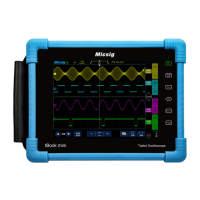Trigger oscilloscope
EN
Tablet1000 User manual Copyright © Qingdao Hantek Electronics Co., LTD
38
9.3 Trigger mode
Oscilloscope trigger mode includes normal, automatic, single trigger. The default mode
is automatic.
⚫ Normal mode: The display waveform is updated only when the oscilloscope has a
valid trigger. The oscilloscope will display the original waveform before replacing it
with a new one. Use normal mode when you only want to see valid triggered
waveforms. Under this mode, the oscilloscope displays the waveform only after the
first trigger.
⚫ Automatic mode: Acquisition can be performed automatically without a valid trigger.
This mode allows untriggered scan waveforms to occur at a time base setting of 100
ms/grid or slower. When the oscilloscope detects a valid trigger, a trigger acquisition
is performed. When the oscilloscope detects that there is no valid trigger, a
none-trigger acquisition is performed.
⚫ Single trigger mode: Enter the stop state after the acquisition only when the
oscilloscope has a valid trigger.
Forced trigger: Under normal and single trigger mode, click the forced trigger button in
the trigger menu to force a trigger signal.
When not getting enough knowledge of the feature of a signal, set in "automatic" mode
to ensure that the oscilloscope has waveform display when other trigger settings are not
correct. Although the waveform may not be stable, it can provide intuitive judgment for
further adjustment.
When we set a specific trigger condition for a specific signal, especially when the time
interval meeting the trigger condition is long, set the trigger mode to "normal" to prevent
the oscilloscope from automatically performing forced trigger.
9.4 Trigger hold-off
Trigger hold-off time indicates the time that oscilloscope waits from triggering to
re-connecting the trigger circuit. During the hold-off period, the oscilloscope does not
re-trigger until the hold-off time is over, hence, setting hold-off time can trigger complex
waveforms stably. The trigger hold-off time ranges from 8ns to 10s.
The hold-off can be triggered on repeated waveforms that have multiple edges (or other
events) between themselves. If the minimum time between triggers is known, you can
also use hold-off to trigger on the first edge of the trigger.

